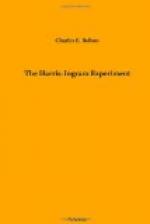Alfonso and Leo arrived from Holland the night before, and each brought paintings of their own skill as presents. Alfonso had done an exquisite full-length portrait of Gertrude in white, the dress, the same that she wore at Smith College graduation. All wondered about Leo’s gift. Gertrude herself cut the strings, and pushed back the paper, while her sister Lucille looked first at her own beautiful likeness and then at Leo. Her face grew crimson, as she said, “Leo, this is just what I most wanted for Gertrude. Thank you! Thank you!” and she came near kissing the handsome artist.
The mother had bought a plentiful supply of those things which daughters most need. The father’s gift was the promised check for $1000, and a mysterious long blue envelope sealed, with the name “Mrs. Gertrude Ingram” written on the outside. Underneath her name were the tantalizing words, “To be opened when she reaches New York.”
“Oh, I so wonder what is inside,” said Gertrude.
May Ingram’s gift was unique; a mahogany box, inlaid with the rare edelweiss, encasing a Swiss phonograph, that was adjusted to play “Elsa’s Dream Song” from Lohengrin on Gertrude’s marriage anniversary, till her golden wedding should occur.
Next morning after the sun had gilded the domes and spires of Paris, the Harrises sat at breakfast in a private room, fragrant with fresh cut flowers. Gertrude wore at her throat her lover’s gift, and she never looked prettier or happier. All the morning till 11 o’clock everybody was busy, when the ushers and friends began to arrive. Soon came the American ambassador, his wife and children. At 11:45 a bishop of New York City, Claude Searles of London, and intimate friends of the Harrises and George Ingram followed, till the private parlors were full.
The orchestra of twenty pieces of Grand Opera House, stationed in the reception hall, played the “Largo” of Handel. In the third parlor from the ceiling were suspended ropes or garlands of smilax and bride’s roses, which formed a dainty canopy. White satin ribbons festooned on two rows of potted marguerites made a bridal pathway direct from the foot of the stairway to the dais beneath the canopy.
On the low platform stood the bishop and the manly bridegroom expectant, when a voice at the foot of the stairway, accompanied by three instruments, sang the Elsa’s Dream Song. The wedding party came downstairs as the orchestra played Wagner’s Wedding March. The bride was dressed in duchess satin of soft ivory tone, the bodice high and long sleeves, with trimming of jewelled point lace. The bridesmaids wore pale yellow cloth, with reveres and cuffs of daffodil yellow satin and white Venetian point. Mrs. Harris wore a gown of heliotrope brocaded silk, trimmed with rich lace and a bodice of velvet.
The wedding party took their places and Mme. Melba accompanied by piano, harp, and violin sang Gounod’s “Ave Maria.”




